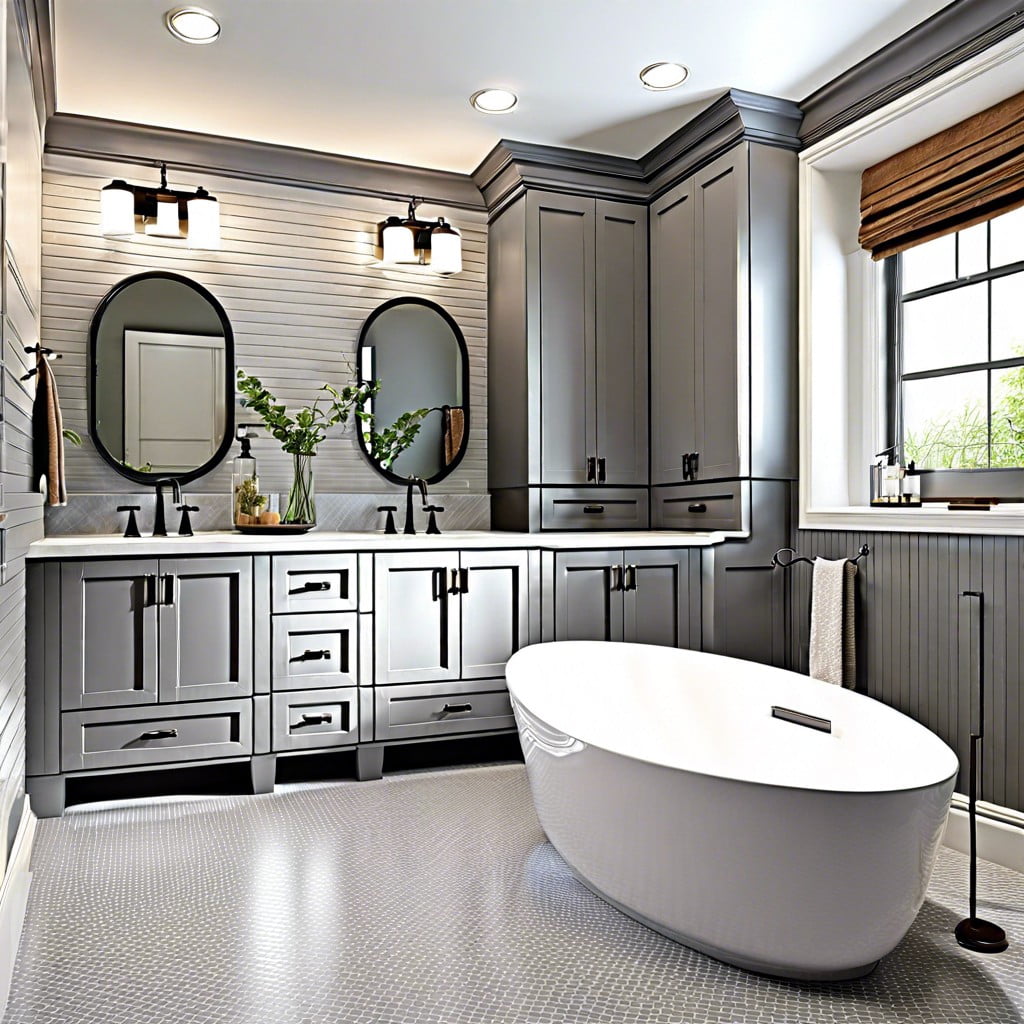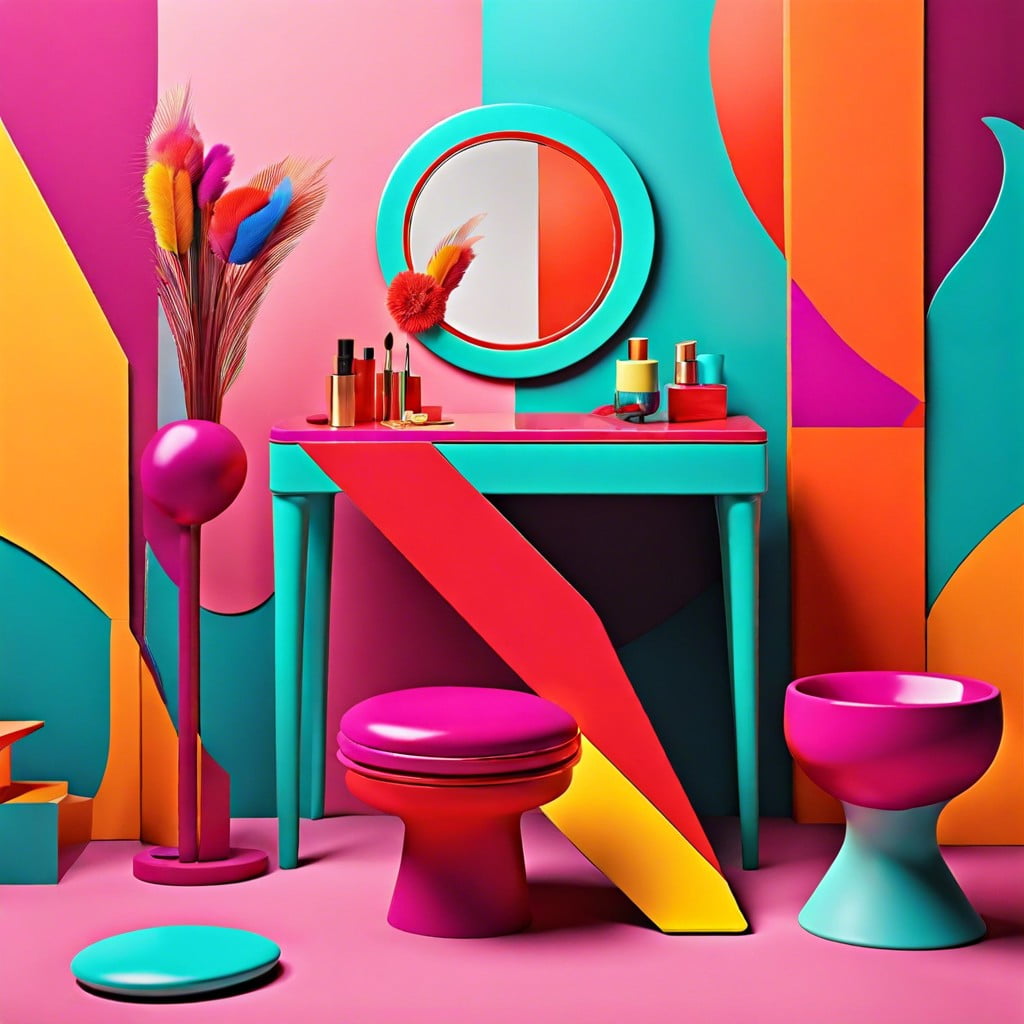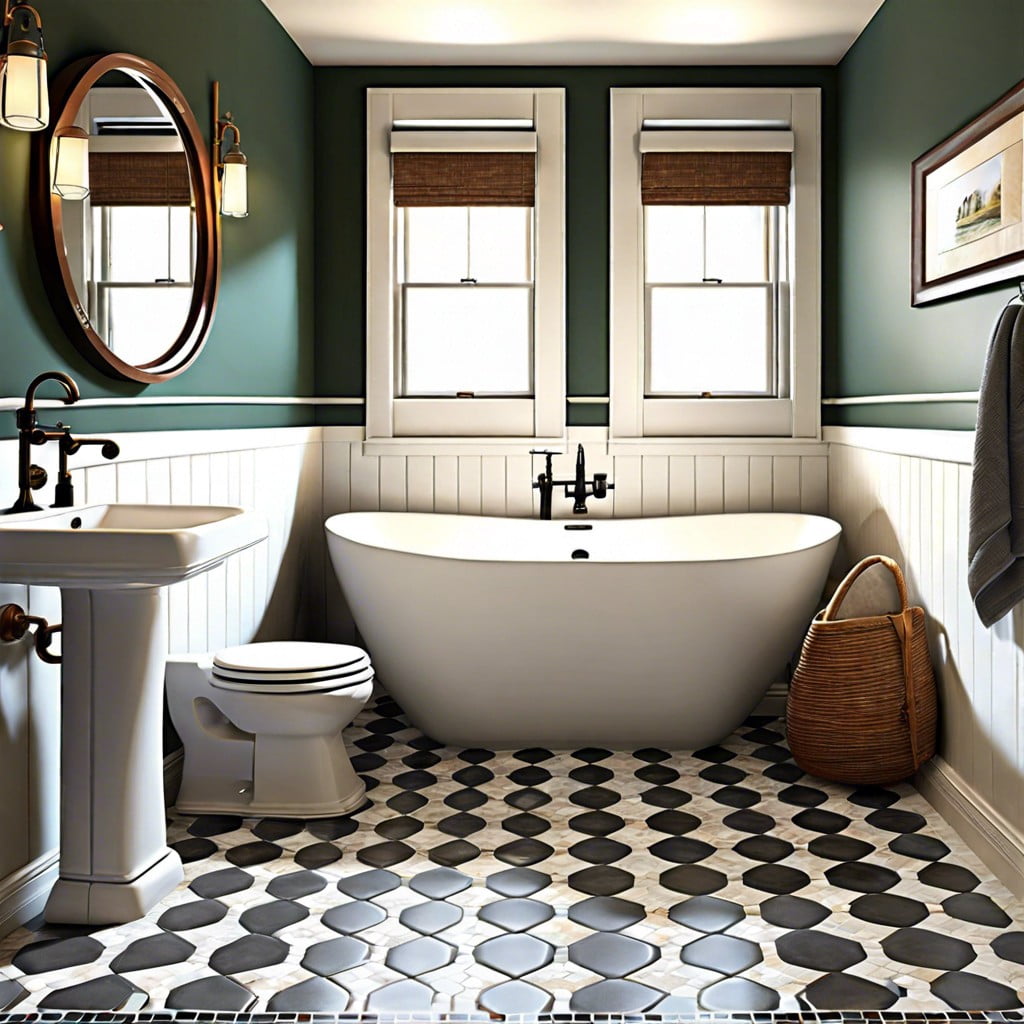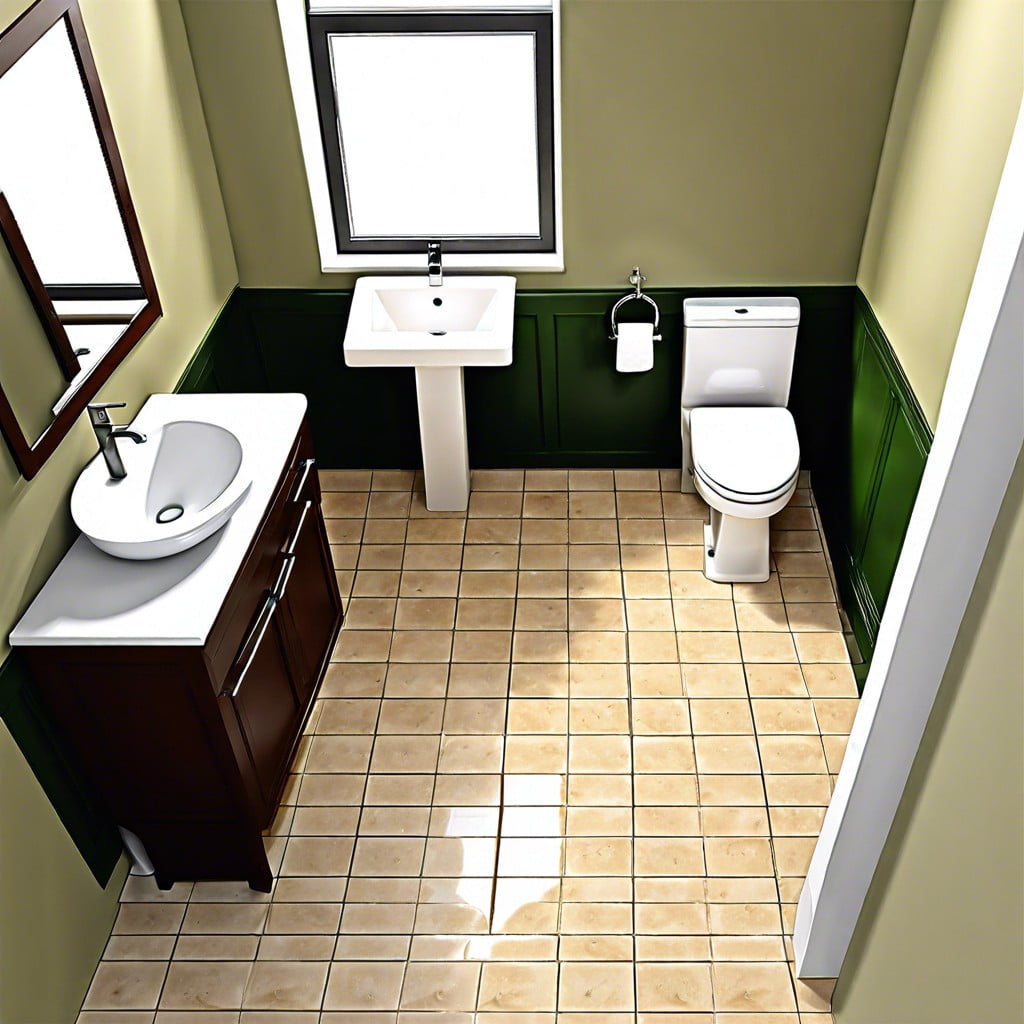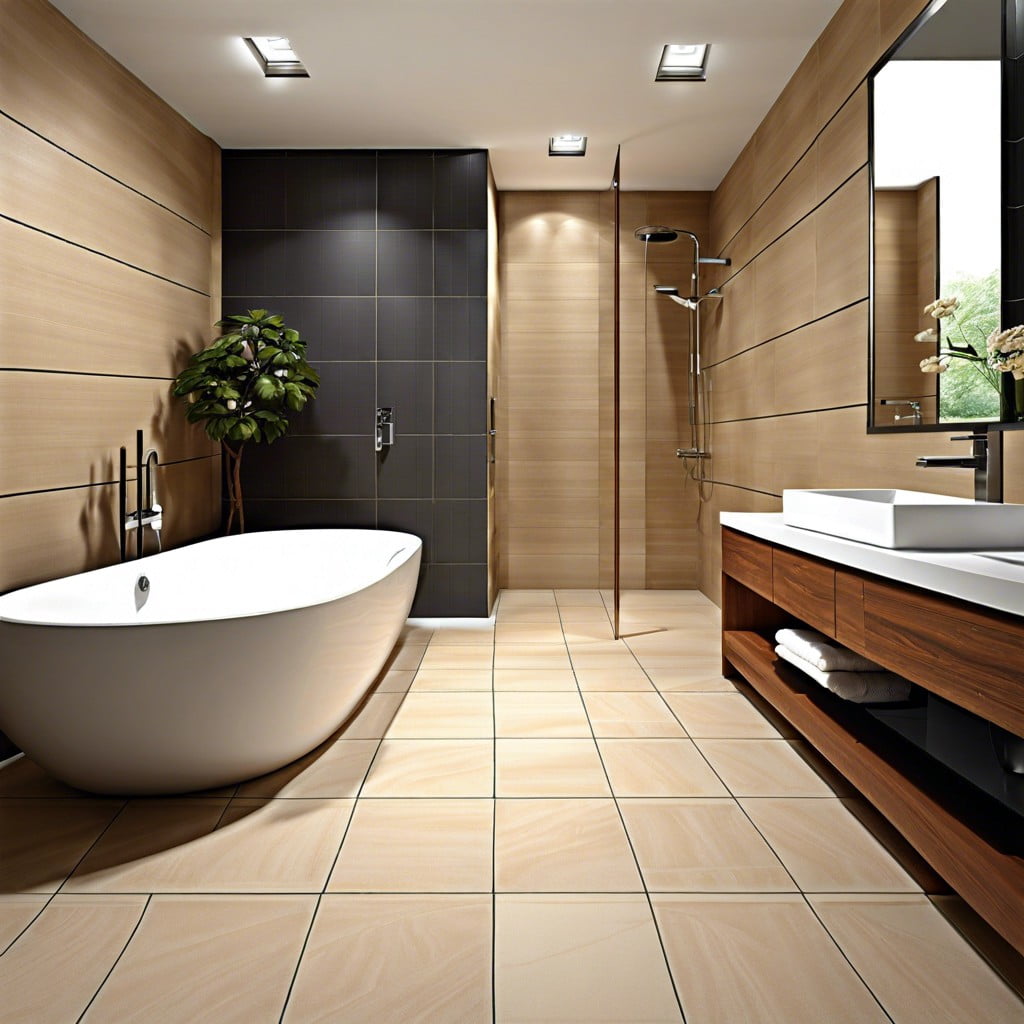Last updated on
In this comparative analysis, we challenge the common assumption that light colors are the only way to make a small bathroom appear larger and consider the influence of different color choices on the perception of space.
Key takeaways:
- Light, airy hues create the illusion of space in a small bathroom.
- Consider the direction of natural light when selecting colors.
- Use mirrors to reflect light and make the bathroom feel open.
- Lighter trim colors blur boundaries and create a sense of openness.
- Choose eggshell or satin finishes for paint sheen.
Optimal Paint Colors for Small Bathrooms
Light, airy hues are the secret sauce for creating the illusion of space in a confined bathroom. Soft neutrals like classic whites, creams, and light grays can open up the room, reflecting light and blurring boundaries. But let’s not shun color – pastel shades such as pale blues and greens subtly add character without overwhelming the senses. These colors invite calmness and a sense of expansion, making your small bathroom feel less like a closet and more like a retreat.
Darker colors tend to absorb light and can enclose the space, so they may not be the first choice for walls. However, they have their own magic when used in accents to provide depth and contrast. Experiment with color temperature as well: colors with cooler undertones can make the walls visually recede, further enhancing spaciousness.
Maximizing Natural Light With Paint Choices
Harnessing the power of natural light can radically affect the spaciousness of a small bathroom. Light, reflective colors are your allies in this endeavor. Pale hues like soft whites, creamy ivories, and pastel tones bounce light around, minimizing shadows that can enclose a space.
Consider the direction of your bathroom’s window—if you have one—when selecting a shade. North-facing rooms can be cooler, benefitting from a warmer tone to enhance brightness, while south-facing can handle cooler tones without feeling stark.
Beyond wall color, think about the ceiling—an often overlooked aspect when aiming to amplify natural light. A high-gloss white paint on the ceiling can act as a reflector, diffusing light throughout the room more effectively than a matte finish. However, be careful with glossier finishes on walls, as too much sheen can create glare instead of gentle diffusion. Semi-gloss is a reasonable choice for areas with high moisture but may not be necessary for walls if strategic lighting fixtures are used.
To further capitalize on the light, select paint colors that complement the tiles and fixtures. Cohesiveness in color promotes a seamless visual flow, which naturally makes a room feel more expansive. Contrast is not the enemy, but in the realm of limited square footage, it should be used judiciously to avoid chopping up the space visually.
Strategically placed mirrors can also work in tandem with your chosen wall color, reflecting both artificial and natural light to make the small bathroom feel more open and airy.
The Role of Trim Color in Perceived Bathroom Size
Trim can be a game-changer in manipulating the dimensions of a small bathroom. Choosing a lighter trim color can blur the boundaries between walls and the ceiling, creating an illusion of a more expansive space. It’s the subtleties, like opting for glossy white baseboards and crown molding, which reflect light, that impart a sense of openness.
Conversely, going bold with darker trims establishes sharp delineations that can actually highlight the compact nature of the room, drawing attention to its limits. This classic framing technique, while making a strong style statement, may inadvertently box in the space.
For a harmonious look, consider extending your wall color to the trim, using the same hue but in a semi-gloss finish. This continuity reduces visual fragmentation and paves the way for a bathroom that feels more like a continuous, open area rather than a collection of chopped up segments.
Tips for Choosing the Right Paint Sheen
Selecting the proper paint sheen is as vital as the hue itself. A high-gloss finish can amplify light reflection, creating an illusion of spaciousness, but it simultaneously highlights every imperfection. This sheen also denies the cozy feel many seek in a bathroom sanctuary.
On the flip side, a flat or matte sheen absorbs light, which could make your space feel like a shadowy cave—quite the opposite of the airy retreat you’re aiming for.
The sweet spot? Eggshell or satin finishes. They offer a slight luster, bouncing light around the room without being overly shiny and are easier to clean than their matte counterparts. Also, consider the moisture level in your bathroom—a semi-gloss may be more appropriate for high humidity areas to prevent mold and ensure durability. However, tread lightly with semi-gloss; its reflectiveness can work against your space-enhancing goals if used excessively.
Common Mistakes in Painting Small Bathrooms
Choosing a dark or overly bold color can overwhelm the space, causing the bathroom to feel cramped and even smaller than it is. Ignoring the ceiling by leaving it white or forgetting to incorporate it into your design strategy is a miss—extending wall color onto the ceiling can create an uninterrupted visual line.
Another common error is neglecting to test paint colors in the bathroom’s unique lighting. Retailer lighting differs from home lighting, and without testing, you might end up with a hue that looks entirely different on your walls.
Additionally, skimping on quality for budget’s sake might lead to using multiple coats, which can result in a thicker paint job that encroaches on the room’s airiness. Buyers must invest in a premium paint for better coverage and a smoother finish to maintain the sense of spaciousness.
FAQ
What color would make a small bathroom look bigger?
Light colors like white, cream, or pale gray, paired with strategic mirror placement, can significantly enhance the sense of space in a small bathroom.
What colors are most flattering in a bathroom?
In my opinion, most flattering bathroom colors are modern blue, light green, and warmer neutrals like taupe, with all-white bathrooms and warm natural undertones also being trendy choices.
How does the use of light colors influence the perception of space in a small bathroom?
Light colors in a small bathroom can significantly expand the perception of space as they reflect more light and create the illusion of an airy, more expansive room.
Does using monochromatic color schemes in a small bathroom contribute to a spacious appearance?
Yes, monochromatic color schemes in a small bathroom can create an illusion of a more spacious area by providing a visual continuity.
How do textures and finishes affect the impression of size when paired with specific bathroom colors?
Textures and finishes can significantly alter the impression of size in a bathroom, with glossy or reflective finishes generally expanding the perceived space, while also enhancing the impact of bathroom colors.
Recap
